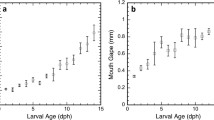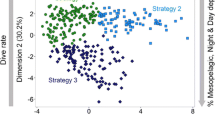Abstract
Capture rates in planktivorous fish may differ in individuals foraging alone or in a group, and this may result either from the altered risk of predation due to vigilance sharing in the group, or from a difference in the intensity of scramble competition for encountered prey items. Changes in capture frequency and the feeding pattern observed in young roach (Rutilus rutilus) feeding alone and in a group of three on a high density prey (Daphnia), in the presence and in the absence of predator odor, were used to determine which of these two alternate explanations is more likely. Earlier studies revealed that a foraging roach captures Daphnia prey in uninterrupted sequences of captures occurring every 1–3 s. Such multiple captures are separated by intermissions of 10–20 s, with their duration being likely to determine the overall capture rate. An experiment was performed to examine whether feeding in a group of three permits higher capture rates (hypothesis 1), and whether the intermittent foraging pattern is due to the need to invest more time for vigilance when foraging alone (hypothesis 2). Video recordings were made of many series of subsequent prey captures by roach feeding on high Daphnia densities, alone or in a group, and in the presence or absence of predator odor. Analysis of these data revealed that the mean duration of intermissions between bursts of feeding activity was significantly greater in the presence of predator odor, which resulted in a significant decrease in the capture rate. Furthermore, when the roach were feeding in a group, these intermissions were reduced to a greater extent in the presence of predator odor than in its absence, implying that the intermission intervals represent an investment for vigilance as an effective antipredation defense that permits increased food intake regardless of whether or not it is enhanced by the resource or the interference competition.




Similar content being viewed by others
References
Beauchamp, G., 2003. Group-size effects on vigilance: a search for the mechanisms. Behavioural Processes 63: 111–121.
Bednekoff, P. A., 2003. Testing explanations of the group size effect on vigilance: let’s be direct. Behavioural Processes 63: 135–136.
Bednekoff, P. A. & S. L. Lima, 1998. Randomness, chaos and confusion in the study of antipredator vigilance. Trends in Ecology and Evolution 13: 284–287.
Bertram, B. C. R., 1980. Vigilance and group size in ostriches. Animal Behaviour 28: 278–286.
Booth, D. J., 1995. Juvenile groups in a coral-reef damselfish: density-dependent effects on individual fitness and population demography. Ecology 76: 91–106.
Brooks, J. L. & S. I. Dodson, 1965. Predation, body size and composition of plankton. Science 150: 28–35.
Clark, C. W. & D. A. Levy, 1988. Diel vertical migrations by juvenile sockeye salmon and the antipredation window. American Naturalist 131: 271–290.
Dodson, S. I., 1989. Predator-induced reaction norms. Bioscience 39: 447–452.
Elgar, M. A., 1989. Predator vigilance and group size in mammals and birds: a critical review of the empirical evidence. Biological Reviews of the Cambridge Philosophical Society (London) 64: 13–33.
Forrester, G. E., 1990. Factors influencing the juvenile demography of a coral reef fish. Ecology 71: 1666–1681.
Foster, W. A. & J. E. Treherne, 1981. Evidence for the dilution effect in the selfish herd from fish predation on a marine insect. Nature 296: 466–467.
George, D. G. & R. W. Edwards, 1973. Daphnia distribution within Langmuir circulations. Limnology and Oceanography 18: 798–800.
Gliwicz, Z. M., 1986. A lunar cycle in zooplankton. Ecology 67: 882–897.
Gliwicz, Z. M., 2003. Between Hazards of Starvation and Risk of Predation: The Ecology of Offshore Animals. International Ecology Institute, Oldendorf/Luhe: 379.
Gliwicz, Z. M. & A. Jachner, 1992. Diel migrations of juvenile fish: a ghost of predation past or present? Archive für Hydrobiologie 124: 385–430.
Gliwicz, Z. M. & D. Wrzosek, 2008. Predation-mediated coexistence of large- and small-bodied Daphnia at different food levels. American Naturalist 172: 358–374.
Gliwicz, Z. M., P. Dawidowicz, A. Jachner & W. Lampert, 2001. Roach habitat shifts and foraging modified by alarm substance. 2. Reasons for different responses of fish in field and laboratory. Archiv für Hydrobiologie 150: 377–392.
Gliwicz, Z. M., J. Slon & I. Szynkarczyk, 2006. Trading safety for food: evidence from gut contents in roach and bleak captured at different distances offshore from their daytime littoral refuge. Freshwater Biology 51: 823–839.
Gliwicz, Z. M., E. Szymanska & D. Wrzosek, 2010. Body size distribution in Daphnia populations as an effect of prey selectivity by planktivorous fish. Hydrobiologia 643: 5–19.
Grand, T. C. & L. M. Dill, 1999. The effect of group size on the foraging behavior of juvenile coho salmon: reduction of predation risk or increased competition? Animal Behavior 58: 443–451.
Havel, J. E. & S. I. Dodson, 1984. Chaoborus predation on typical and spine morphs of Daphnia pulex: behavioral observations. Limnology and Oceanography 29: 487–494.
Isaacson, A. J. & N. J. Westwood, 1971. The significance of gregarious feeding behaviour and adrenal stress in a population of wood-pigeons, Columba palumbus. Journal of Zoology (London) 165: 53–84.
Jachner, A., 1996. Alarm reaction in bleak (Alburnus alburnus (L)) in response to chemical stimuli from injured conspecifics. Hydrobiologia 325: 151–155.
Jachner, A. & T. Janecki, 1999. Feeding and growth response of roach, Rutilus rutilus, to alarm substance. Environmental Biology of Fishes 54: 433–437.
Johnsson, J. I., 2003. Group size influences foraging effort independent of predation risk: an experimental study on rainbow trout. Journal of Fish Biology 63: 863–870.
Krebs, J. R., 1974. Colonial nesting and social feeding as strategies for exploiting food resources in the Great Blue Heron (Ardea herodias). Behaviour 51: 99–134.
Krebs, J. R. & N. B. Davies, 1993. An Introduction to Behavioural Ecology, 3rd ed. Blackwell Science, Oxford: 420.
Krebs, J. R. & N. B. Davies, 1997. Behavioural Ecology: An Evolutionary Approach. Blackwell Science, Oxford: 446.
Krebs, J. R., M. H. MacRoberts & J. M. Cullen, 1972. Flocking and feeding in the great tit Parus major: an experimental study. Ibis 114: 507–530.
Krueger, D. A. & S. I. Dodson, 1981. Embryological induction and predation ecology of Daphnia pulex. Limnology and Oceanography 26: 212–223.
Lampert, W. & C. J. Loose, 1992. Plankton towers: bridging the gap between laboratory and field experiments. Archiv fűr Hydrobiologie 126: 53–66.
Lima, S. L., 1998. Stress and decision making under the risk of predation: developments from behavioral, reproductive, and ecological perspectives. In Møller, A. P., M. Milinski & P. J. B. Slater (eds), Stress and Behavior. Advances in the Study of Behavior, Vol. 27. Academic Press, San Diego: 215–290.
Lima, S. L., P. A. Zollner & P. A. Bednekoff, 1999. Predation, scramble competition, and the vigilance group size effect in dark-eyed juncos (Junco hyemalis). Behavioral Ecology and Sociobiology 46: 110–116.
Magurran, A. E., 1989. Acquired recognition of predator odour in the European minnow (Phoxinus phoxinus). Ethology 82: 216–223.
Magurran, A. E., W. J. Oulton & T. J. Pitcher, 1985. Vigilant behaviour and school size in minnows. Zeitschrift fur Tierpsychologie 67: 167–178.
McNamara, J. M. & A. I. Houston, 1985. Optimal foraging and learning. Journal of Theoretical Biology 117: 231–249.
McNaught, D. C. & A. D. Hasler, 1961. Surface schooling and feeding behavior in the white bass, Roccus chrysops (Rafinesque), in Lake Mendota. Limnology and Oceanography 6: 53–60.
Milinski, M. & R. Heller, 1978. Influence of a predator on the optimal foraging behaviour of sticklebacks (Gasterosteus aculeatus L.). Nature 275: 642–644.
Neill, S. R. & J. M. Cullen, 1974. Experiments on whether schooling by their prey affects the hunting behaviour of cephalopods and fish predators. Journal of Zoology (London) 172: 549–569.
O’Brien, W. J., 1987. Planktivory by freshwater fish: thrust and parry in the pelagia. In Kerfoot, W. C. & A. Sih (eds), Predation: Direct and Indirect Impacts on Aquatic Communities. University Press of New England, Hanover and London: 5–16.
O’Brien, W. J., N. A. Slade & G. L. Viniard, 1976. Apparent size as the determinant of prey selection by bluegill sunfish (Lepomis macrochirus). Ecology 57: 1304–1310.
Pitcher, T. J., 1986. The function of schooling behaviour in teleosts. In Pitcher, T. J. (ed.), The Behaviour of Teleost Fishes. The John Hopkins University Press, Baltimore, Maryland: 294–337.
Pitcher, T. J. & J. K. Parrish, 1993. Functions of shoaling behaviour in teleosts. In Pitcher, T. J. (ed.), Behaviour of Teleost Fishes. Chapman & Hall, London: 363–439.
Pitcher, T. J., A. E. Magurran & T. J. Winfield, 1982. Fish in larger shoals find food faster. Behavioral Ecology and Sociobiology 10: 149–151.
Rygielska-Szymanska, E., 2009. Size distribution and age structure of a Daphnia population as an effect of size-selective predation by planktivorous fishes. PhD Thesis, University of Warsaw (in Polish, English summary).
Smith, P. C. & P. R. Evans, 1973. Studies of shorebirds at Lindisfarne, Northumberland. I. Feeding ecology and behaviour of the bar-tailed godwit. Wildfowl 24: I35–I39.
White, J. W. & R. R. Warner, 2007. Behavioral and energetic costs of group membership in a coral reef fish. Oecologia 154: 423–433.
Winfield, I. J., 1990. Predation pressure from above: observations on the activities of piscivorous birds at a shallow eutrophic lake. Hydrobiologia 191: 223–231.
Acknowledgments
We thank Ewa Rygielska-Szymanska for discussions on the initial idea and for making her experimental setup available to this study, Anna Przytulska-Bartosiewicz for assistance with the field and experimental work, William R. DeMott for supplying us with his clone of Daphnia pulex × pulicaria, Gerardo Ortiz, Nandini Sarma, and S.S.S. Sarma for providing a homely environment at Iztacala Campus of the Universidad Nacional Autonoma de Mexico in which to write the manuscript, and Piotr Maszczyk, John Gittins, Piet Spaak, and the reviewers for their valuable and very constructive comments on earlier drafts of this manuscript. This research was supported by Grants from the State Committee for Scientific Research, Poland, 6P04F01921 and 2P04G01430 to Z.M. Gliwicz.
Author information
Authors and Affiliations
Corresponding author
Additional information
Guest editors: H. J. Dumont, J. E. Havel, R. Gulati & P. Spaak / A Passion for Plankton: a tribute to the life of Stanley Dodson
Rights and permissions
About this article
Cite this article
Bartosiewicz, M., Gliwicz, Z.M. Temporary intermissions in capturing prey (Daphnia) by planktivorous fish (Rutilus rutilus): Are they due to scramble competition or the need for antipredation vigilance?. Hydrobiologia 668, 125–136 (2011). https://doi.org/10.1007/s10750-010-0577-0
Received:
Accepted:
Published:
Issue Date:
DOI: https://doi.org/10.1007/s10750-010-0577-0




